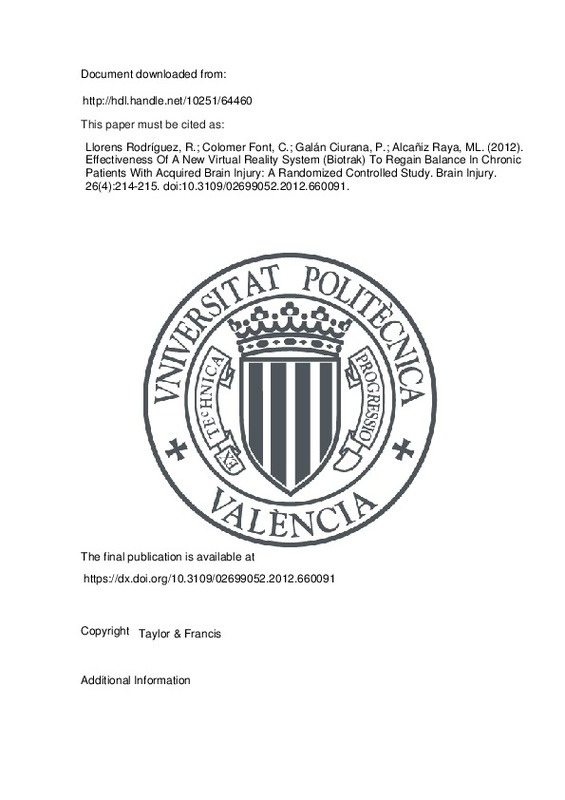JavaScript is disabled for your browser. Some features of this site may not work without it.
Buscar en RiuNet
Listar
Mi cuenta
Estadísticas
Ayuda RiuNet
Admin. UPV
Effectiveness Of A New Virtual Reality System (Biotrak) To Regain Balance In Chronic Patients With Acquired Brain Injury: A Randomized Controlled Study
Mostrar el registro sencillo del ítem
Ficheros en el ítem
| dc.contributor.author | Llorens Rodríguez, Roberto
|
es_ES |
| dc.contributor.author | Colomer Font, Carolina
|
es_ES |
| dc.contributor.author | Galán Ciurana, Pilar
|
es_ES |
| dc.contributor.author | Alcañiz Raya, Mariano Luis
|
es_ES |
| dc.date.accessioned | 2016-05-20T07:59:41Z | |
| dc.date.available | 2016-05-20T07:59:41Z | |
| dc.date.issued | 2012-04-12 | |
| dc.identifier.issn | 0269-9052 | |
| dc.identifier.uri | http://hdl.handle.net/10251/64460 | |
| dc.description.abstract | [EN] In the last years, the potential benefits of virtual reality in the rehabilitation process have been highlighted by several studies. This fact has given rise to a great number of virtual rehabilitation systems. However, just a few focus on balance rehabilitation, although it is one of the most disabling impairments. BioTrak is a virtual rehabilitation system that provides exercises for the rehabilitation of different deficits. The objective of this study is to describe the clinical validation of the balance exercises through reaching movements in patients with acquired brain injury (ABI) | es_ES |
| dc.language | Inglés | es_ES |
| dc.publisher | Taylor & Francis | es_ES |
| dc.relation.ispartof | Brain Injury | es_ES |
| dc.rights | Reserva de todos los derechos | es_ES |
| dc.subject | Virtual rehabilitation | es_ES |
| dc.subject | Neurorehabilitation | es_ES |
| dc.subject | Acquired brain injury | es_ES |
| dc.subject.classification | EXPRESION GRAFICA EN LA INGENIERIA | es_ES |
| dc.title | Effectiveness Of A New Virtual Reality System (Biotrak) To Regain Balance In Chronic Patients With Acquired Brain Injury: A Randomized Controlled Study | es_ES |
| dc.type | Artículo | es_ES |
| dc.identifier.doi | 10.3109/02699052.2012.660091 | |
| dc.rights.accessRights | Abierto | es_ES |
| dc.contributor.affiliation | Universitat Politècnica de València. Instituto Interuniversitario de Investigación en Bioingeniería y Tecnología Orientada al Ser Humano - Institut Interuniversitari d'Investigació en Bioenginyeria i Tecnologia Orientada a l'Ésser Humà | es_ES |
| dc.contributor.affiliation | Universitat Politècnica de València. Departamento de Ingeniería Gráfica - Departament d'Enginyeria Gràfica | es_ES |
| dc.description.bibliographicCitation | Llorens Rodríguez, R.; Colomer Font, C.; Galán Ciurana, P.; Alcañiz Raya, ML. (2012). Effectiveness Of A New Virtual Reality System (Biotrak) To Regain Balance In Chronic Patients With Acquired Brain Injury: A Randomized Controlled Study. Brain Injury. 26(4):214-215. doi:10.3109/02699052.2012.660091 | es_ES |
| dc.description.accrualMethod | S | es_ES |
| dc.relation.publisherversion | https://dx.doi.org/10.3109/02699052.2012.660091 | es_ES |
| dc.description.upvformatpinicio | 214 | es_ES |
| dc.description.upvformatpfin | 215 | es_ES |
| dc.type.version | info:eu-repo/semantics/publishedVersion | es_ES |
| dc.description.volume | 26 | es_ES |
| dc.description.issue | 4 | es_ES |
| dc.relation.senia | 231187 | es_ES |
| dc.identifier.eissn | 1362-301X | |
| dc.description.references | Castellanos, N. P., Paúl, N., Ordóñez, V. E., Demuynck, O., Bajo, R., Campo, P., … Maestú, F. (2010). Reorganization of functional connectivity as a correlate of cognitive recovery in acquired brain injury. Brain, 133(8), 2365-2381. doi:10.1093/brain/awq174 | es_ES |
| dc.description.references | Sherer, M., Nakase-Thompson, R., Yablon, S. A., & Gontkovsky, S. T. (2005). Multidimensional Assessment of Acute Confusion After Traumatic Brain Injury. Archives of Physical Medicine and Rehabilitation, 86(5), 896-904. doi:10.1016/j.apmr.2004.09.029 | es_ES |
| dc.description.references | Sherer, M., Yablon, S. A., Nakase-Richardson, R., & Nick, T. G. (2008). Effect of Severity of Post-Traumatic Confusion and Its Constituent Symptoms on Outcome After Traumatic Brain Injury. Archives of Physical Medicine and Rehabilitation, 89(1), 42-47. doi:10.1016/j.apmr.2007.08.128 | es_ES |
| dc.description.references | Ayalon, L., Borodkin, K., Dishon, L., Kanety, H., & Dagan, Y. (2007). Circadian rhythm sleep disorders following mild traumatic brain injury. Neurology, 68(14), 1136-1140. doi:10.1212/01.wnl.0000258672.52836.30 | es_ES |
| dc.description.references | Bushnik, T., Englander, J., & Katznelson, L. (2007). Fatigue after TBI: Association with neuroendocrine abnormalities. Brain Injury, 21(6), 559-566. doi:10.1080/02699050701426915 | es_ES |
| dc.description.references | Clinchot, D. M., Bogner, J., Mysiw, W. J., Fugate, L., & Corrigan, J. (1998). DEFINING SLEEP DISTURBANCE AFTER BRAIN INJURY1. American Journal of Physical Medicine & Rehabilitation, 77(4), 291-295. doi:10.1097/00002060-199807000-00006 | es_ES |
| dc.description.references | Glickman, G., Byrne, B., Pineda, C., Hauck, W. W., & Brainard, G. C. (2006). Light Therapy for Seasonal Affective Disorder with Blue Narrow-Band Light-Emitting Diodes (LEDs). Biological Psychiatry, 59(6), 502-507. doi:10.1016/j.biopsych.2005.07.006 | es_ES |
| dc.description.references | Giacino, J. T., Kalmar, K., & Whyte, J. (2004). The JFK Coma Recovery Scale-Revised: Measurement characteristics and diagnostic utility11No commercial party having a direct financial interest in the results of the research supporting this article has or will confer a benefit upon the authors or upon any organization with which the authors are associated. Archives of Physical Medicine and Rehabilitation, 85(12), 2020-2029. doi:10.1016/j.apmr.2004.02.033 | es_ES |
| dc.description.references | Schnakers, C., Perrin, F., Schabus, M., Majerus, S., Ledoux, D., Damas, P., … Laureys, S. (2008). Voluntary brain processing in disorders of consciousness. Neurology, 71(20), 1614-1620. doi:10.1212/01.wnl.0000334754.15330.69 | es_ES |
| dc.description.references | Rohling, M. L., Binder, L. M., Demakis, G. J., Larrabee, G. J., Ploetz, D. M., & Langhinrichsen-Rohling, J. (2011). A Meta-Analysis of Neuropsychological Outcome After Mild Traumatic Brain Injury: Re-analyses and Reconsiderations of Binder et al. (1997), Frencham et al. (2005), and Pertab et al. (2009). The Clinical Neuropsychologist, 25(4), 608-623. doi:10.1080/13854046.2011.565076 | es_ES |
| dc.description.references | Iverson, G. L. (2010). Mild traumatic brain injury meta-analyses can obscure individual differences. Brain Injury, 24(10), 1246-1255. doi:10.3109/02699052.2010.490513 | es_ES |
| dc.description.references | Demertzi, A., Schnakers, C., Ledoux, D., Chatelle, C., Bruno, M.-A., Vanhaudenhuyse, A., … Laureys, S. (2009). Different beliefs about pain perception in the vegetative and minimally conscious states: a European survey of medical and paramedical professionals. Coma Science: Clinical and Ethical Implications, 329-338. doi:10.1016/s0079-6123(09)17722-1 | es_ES |







![[Cerrado]](/themes/UPV/images/candado.png)

